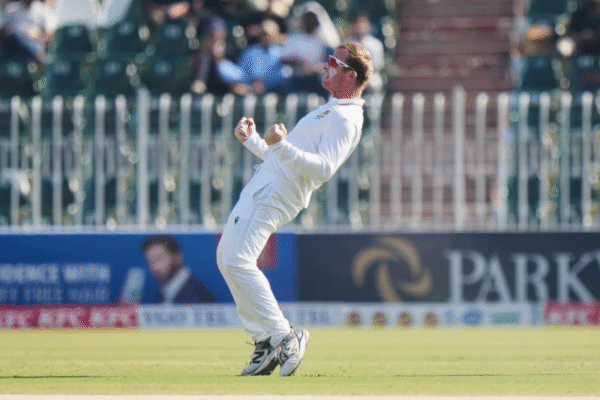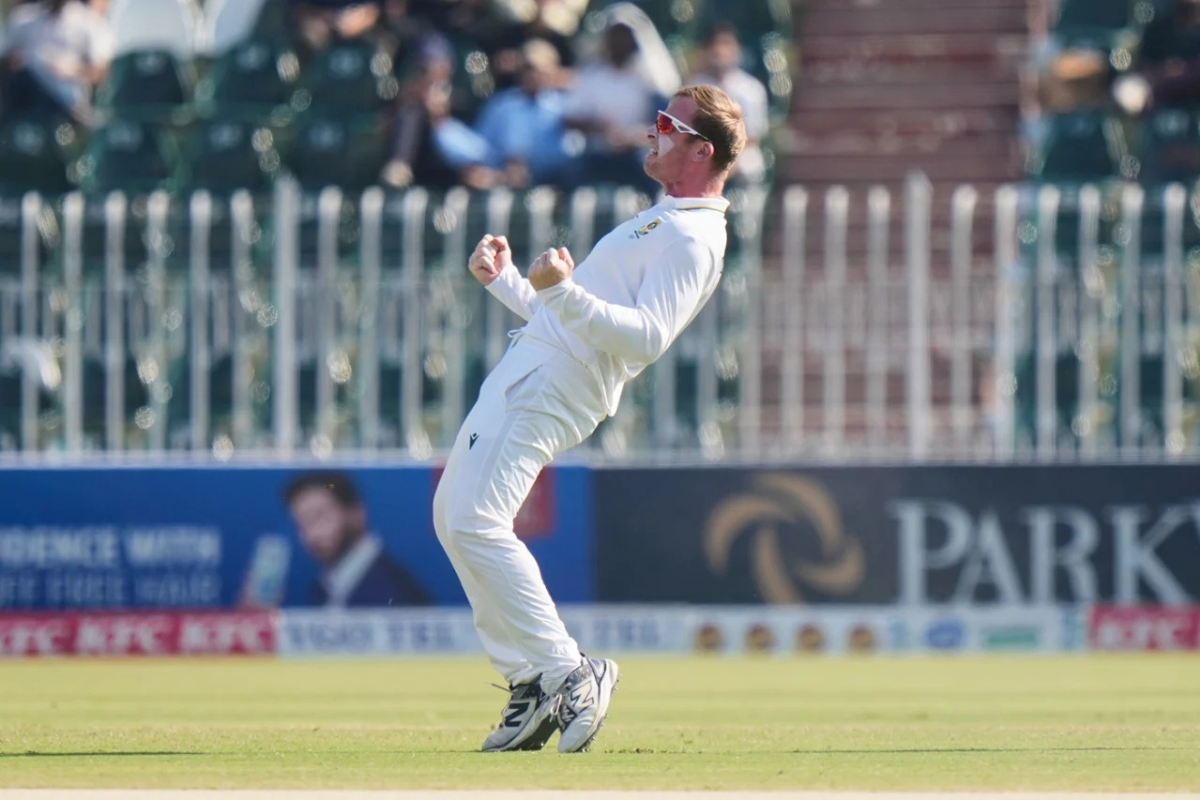
Simon Harmer became only the fourth South African cricketer to breach 1000 first-class wickets in 21st century.

In the era dominated by T20 franchise leagues, the longevity of red-ball cricket has been gradually diminishing. Despite that, a select group of players has defied the odds and achieved a rare feat in the longest format of the game. A new name, Simon Harmer, has now entered the elite list of bowlers who have taken over 1,000 wickets in first-class cricket, grinding day in and day out while mastering the craft of the longest format.
Here’s a look at the elite list of bowlers, featuring legends of the game and modern masters, including Simon Harmer and James Anderson.
Mushtaq Ahmed, the legendary Pakistani spinner, produced a full range of leg-spin variations. A true match-winner, he was considered to be nearly on par with his contemporary Shane Warne. His deceptive googlies and variations made him a nightmare for batters in domestic cricket, especially on tracks that primarily aided pacers. He also dominated international cricket, claiming 185 wickets in 52 Tests, including ten five-wicket hauls and three ten-wicket match hauls.
During his red-ball career, the off-spinner took 1,407 wickets in 309 matches at an impressive average of 25.67, with over 100 five-wicket hauls (104) and 32 ten-wicket match hauls, cementing his place among the greats of the game.
The undisputed king of spin, Muttiah Muralitharan’s record speaks for itself. His ability to turn the ball sharply on even dead surfaces, combined with his stamina for marathon spells, allowed him to dominate consistently. He finished as the highest wicket-taker not just in Test cricket (800 wickets), but in international cricket, despite playing only 12 T20Is in his career. Remarkably, he averaged less than 30 with the ball in every country except India and Australia.
Muralitharan ranks second on the list of players with the most first-class wickets in the 21st century, having taken 1,374 wickets in just 232 red-ball matches at a staggering average of 19.64, including 119 five-wicket hauls and 34 ten-wicket match hauls. He also holds the record for most Test wickets, with 800 scalps in 133 Tests at an average of 22.72, including the highest number of five-wicket (67) and ten-wicket match hauls (22) in Test cricket history.
Arguably one of the greatest bowlers to ever play the game, Shane Warne redefined spin bowling. He brought a unique style to slow bowling, with his famous walks up to the crease and aggressive mindset. Although he struggled initially in Test cricket after making his debut in 1992, Warne found immense success against all teams, particularly England and South Africa. He retired in 2007 with a staggering 1,319 wickets in 301 first-class matches, including 69 five-wicket hauls and 12 ten-wicket match hauls, alongside 6,919 runs, including two centuries.
A tall pacer relied upon for bounce and seam movement, Andy Caddick remains a key figure in England’s cricketing history. While he was known as a ‘rhythm bowler’—unplayable when in form but occasionally inconsistent- Caddick left an indelible mark. He retired after the 2003 World Cup, finishing with 1,180 wickets in 275 first-class matches at an average of 26.59, including 78 five-wicket hauls and 17 ten-wicket match hauls. Among these, 234 wickets came in Tests, with 13 five-wicket hauls and one ten-wicket match haul.
The Welsh off-spinner Robert Croft, known for his deceptive arm ball and flight, did not enjoy a long international career, featuring in only 21 Tests and taking 49 wickets at 37.24. However, he was a domestic giant, claiming 1,175 wickets in 407 first-class matches. Croft’s longevity and determination to continue playing at the domestic level, even after falling out of England’s plans early in his career, is a testament to his resilience.
India’s ‘Jumbo,’ Anil Kumble, an orthodox spinner who relied more on accuracy and tactics than spin, was one of the greatest match-winners in Indian cricket. Playing in an era alongside Muralitharan and Shane Warne, Kumble finished with 619 Test wickets, second only to Muralitharan. He ended his career with 1,136 first-class wickets in 244 matches, including 72 five-wicket hauls and 19 ten-wicket match hauls.
Sri Lanka’s Rangana Herath was often compared to Australia’s Stuart MacGill—a consistent domestic performer who had to compete in an era dominated by Muralitharan. Herath made his Test debut in 1999 but made his mark from 2012 onward, finishing with 433 Test wickets in 93 matches. His first-class record is equally impressive, with 1,080 wickets in 270 matches at 25.14. Known for his control and flight, he often operated as a lone spinner, dismantling batting line-ups across continents
A county cricket stalwart, Martin Bicknell’s consistency for Surrey was remarkable. Despite playing only four Tests for England, the right-arm seamer took 1,061 first-class wickets and scored 6,740 runs in 292 matches.
Standing six feet tall, Phil Tufnell, who represented Middlesex, was known for his exceptional control and the famous “ball on a string.” Nicknamed ‘The Cat’ for his love of naps in the dressing room, Tufnell was nonetheless a formidable left-arm spinner. He ended his career with 1,057 wickets in 316 matches at an average of 29.35, including 53 five-wicket hauls.
ALSO READ:
Renowned for raw pace, Devon Malcolm combined speed with confidence and endurance. He retired at 37, finishing with 1,054 wickets in 304 first-class matches at 30.33, including 46 five-wicket hauls. His iconic 9-57 spell against South Africa remains legendary.
One of the greatest left-arm bowlers in history, Wasim Akram, was poetry in motion. Known for control, swing, reverse swing, and delivering under pressure, he excelled across formats. Akram finished with 1,042 wickets in 257 first-class matches at an average of 21.64, including 70 five-wicket hauls.
Pakistan’s leg-spinner Danish Kaneria was a constant threat in domestic cricket. He ended his career as Pakistan’s highest wicket-taking spinner and claimed 1,024 first-class wickets. Despite his international ban, his domestic exploits remain exceptional.
A domestic stalwart for Sri Lanka, Hettiarachchi played only one Test but amassed 1,000 wickets in 234 first-class matches at 23.54. His 71 five-wicket hauls and 18 ten-wicket match hauls underscore the importance of perseverance in domestic cricket.
England’s legendary pacer, James Anderson, holds the record for most wickets in Test cricket by a fast bowler. Among players who debuted in the 21st century, he was the first to cross 1,000 first-class wickets. Anderson finished with 1,143 wickets in 304 first-class matches, including 704 in Tests, showcasing his unmatched control, seam movement, and longevity.
South Africa’s off-spinner Simon Harmer joined this elite club in 2025, becoming the fourth South African to reach 1,000 first-class wickets. The right-arm off-spinner claimed a six-fer in the second innings of the Rawalpindi Test against Pakistan, taking his first-class tally to 1,000 wickets. Since joining Essex in 2017, he has taken over 500 wickets for the club in the County Championship. Known for his control and consistency, Harmer is one of only two bowlers to debut after 2000 and still achieve the 1,000-wicket milestone. Despite his dominance in domestic cricket, he has featured in only 12 Tests, taking 52 wickets in 20 innings.
For more updates, follow CricXtasy on Facebook, Instagram, Twitter, and YouTube.